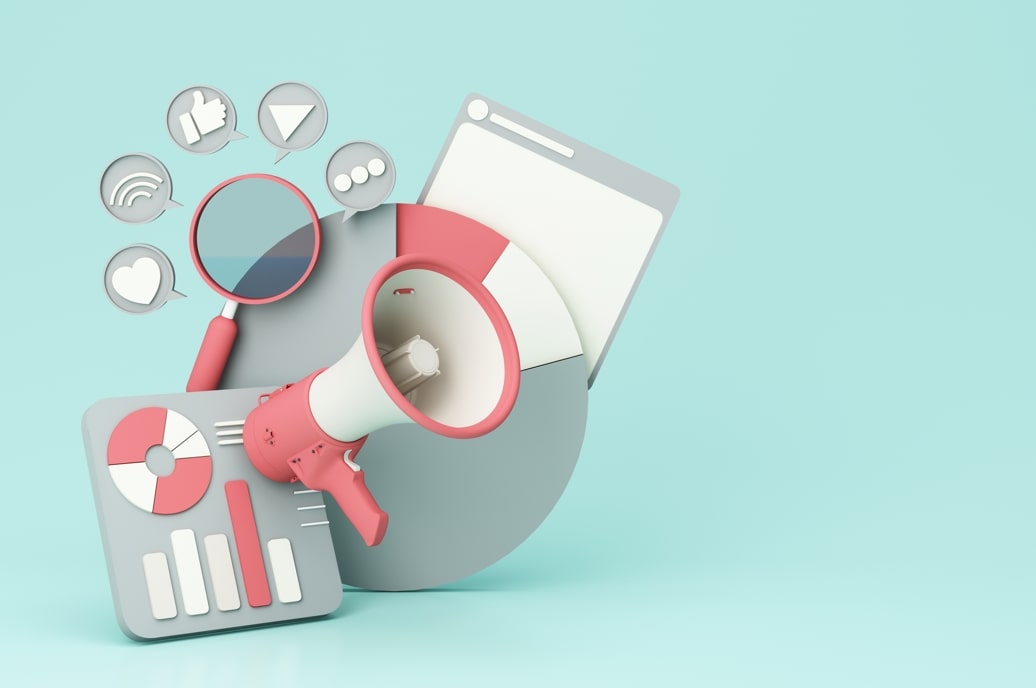Every business faces the same crossroad: Should you invest in building a loyal audience slowly or buy visibility overnight? This is the core tension between organic and inorganic marketing strategies — two approaches with vastly different costs, timelines, and outcomes.
Organic marketing (think SEO, social media engagement, or viral content) grows your brand credibility over time. Inorganic tactics (paid ads, sponsorships, influencer boosts) deliver immediate reach — but at a price. Neither is “better,” but misjudging their roles wastes budgets, frustrates teams, and leaves customers cold.
This isn’t a debate about quality vs. speed. It’s about strategy. This article breaks down how both approaches work, where they stumble, and how to blend them to turn passive scrollers into lifelong buyers. Stuck choosing between SEO and paid ads? Let’s simplify.
What is organic marketing
Organic marketing refers to the use of unpaid, non-promotional tactics to grow brand awareness, engagement, and customer loyalty by delivering value aligned with audience needs. It prioritizes authenticity over interruption, focusing on building relationships through content, community, and search engine visibility rather than paid media buys.
At its core, organic marketing is audience-centric: It addresses existing demand (e.g., answering questions via blog posts, solving problems through tutorials) rather than creating artificial demand through ads. This approach relies on platforms’ native algorithms (Google, social media) to distribute content to users actively seeking solutions, fostering long-term trust and authority.

Key distinctions from inorganic strategies:
- No Direct Paid Promotion: Organic efforts avoid paid ads, sponsorships, or boosted posts.
- Linked to Audience Intent: Targets users already in “research” or “problem-solving” mode (e.g., searching “best CRM for small businesses”).
- Credibility-Driven: Success hinges on perceived expertise, not budget size.
Examples include a software company ranking #1 on Google for “free project management tools” through SEO-optimized content, or a skincare brand growing a TikTok following by sharing user-generated testimonials.
Organic marketing’s efficacy depends on patience, consistency, and alignment with audience behavior — making it less a “campaign” and more a foundational brand-building discipline.
Common organic marketing channels
Search engine optimization (SEO)
Search engine optimization (SEO) focuses on driving unpaid traffic by aligning content with search engine algorithms and user intent. This involves optimizing meta titles, headers, and keywords (on-page SEO), earning backlinks through guest posts or partnerships (off-page SEO), and improving technical elements like site speed or mobile responsiveness.
For example, a B2B SaaS company might create in-depth comparisons of “cloud accounting software” to rank for niche keywords like “best cloud accounting tools for startups.”
Content marketing
Content marketing attracts and retains audiences by solving problems or addressing interests through blogs, case studies, and video tutorials. A fitness app targeting “no-gym fitness routines” could publish detailed “30-Day Home Workout Plans,” combining instructional guides with actionable tips to build authority.
Organic social media engagement
Organic social media engagement fosters community loyalty through platform-specific strategies, such as Instagram Reels for fitness tutorials or LinkedIn carousels for industry insights. Brands might launch hashtag challenges to encourage user-generated content or respond directly to comments and polls to deepen relationships.
Email marketing
Email marketing nurtures leads with personalized sequences, like onboarding emails for new subscribers or segmented campaigns offering discounts to inactive users. A SaaS company could drip educational content such as a “7-Day SEO Basics Course” to gradually build trust and expertise.
Referral
Referral strategies turn loyal customers or micro-influencers into advocates by incentivizing shares—like Dropbox’s “earn free storage” program—or collaborating with niche creators for authentic reviews. A skincare brand might partner with eco-conscious influencers to amplify credibility without paid promotions.
Each tactic thrives when tailored to audience needs and integrated into a cohesive strategy.
Advantages of organic marketing
- Long-term cost efficiency: Once established, top-ranking content requires minimal upkeep. Example: A well-optimized blog post can generate traffic for 5+ years.
- Trust & brand authority: Users perceive organic content as unbiased (vs. ads). Example: 72% of consumers trust online reviews as much as personal recommendations (BrightLocal).
- Sustainable audience growth: Targets users actively seeking solutions (high-intent traffic). Example: A “best running shoes” guide attracts buyers in the consideration phase.
- Scales with time: Content compounds as backlinks and shares increase domain authority.
Disadvantages of organic marketing
- Time-to-results is slow: Building domain authority, social followers, or content libraries takes months (or years). Example: New blogs may take 6–12 months to rank on Google’s first page.
- Vulnerability to algorithm changes: Platforms like Google or Instagram can deprioritize your content overnight. Example: Brands relying on “how-to” YouTube tutorials saw traffic drop after algorithm shifts to favor short-form video.
- Resource-intensive: Requires consistent investment in skilled teams (writers, SEO specialists, community managers) and tools (analytics software, keyword trackers).
- Difficult to scale quickly: Organic reach plateaus without paid amplification. Example: A startup needing rapid user growth may struggle without ads.
- Hard to measure direct ROI: Attribution is complex (e.g., tracking if a sale came from a blog, social post, or email).
Organic marketing delivers sustainable growth and credibility but demands patience, adaptability, and upfront effort. It’s most effective for brands with long-term goals and resources to weather slow starts.
What is an inorganic marketing strategy?
An inorganic marketing strategy uses paid, short-term tactics to accelerate brand visibility, traffic, or conversions. It focuses on buying ad inventory or partnerships to reach audiences who aren’t actively searching for your brand, often prioritizing speed over organic credibility.

Key distinctions from organic strategies:
- Paid placement: Relies on third-party platforms (Google Ads, Facebook, sponsored content) to target users.
- Controlled scalability: Reach expands proportionally to budget.
- Immediate impact: Delivers results within days or hours of activation.
Common inorganic marketing channels
Pay-per-click advertising
Pay-per-click advertising allows businesses to bid for ad placements across search engines, social feeds, or third-party websites. Brands target specific keywords like “buy running shoes” with text-based search ads or deploy display ads to retarget users who previously visited their site. E-commerce companies often leverage shopping ads, which showcase products directly in search results, combining images, prices, and reviews for instant visibility.
Social media advertising
Social media advertising offers hyper-targeted campaigns on platforms like Facebook, Instagram, or TikTok. Tactics include boosting high-performing organic posts to expand reach among selected demographics, creating carousel ads to display multiple products in a single swipeable format, or using lead ads to capture user information through pre-filled forms. For instance, a skincare brand might use Instagram carousels to highlight different uses of a serum.
Sponsored content
Sponsored content & native ads involve paying publishers like Forbes or niche blogs to feature branded articles or videos that blend seamlessly with editorial content. A fintech company might sponsor a piece titled “Top Investment Tools for Millennials” to position itself as a thought leader while subtly promoting its platform.
Influencer paid partnerships
Influencer paid partnerships involve compensating creators to showcase products authentically. A beauty brand could collaborate with a TikTok influencer to demonstrate a “#Sponsored makeup tutorial,” leveraging the creator’s audience for credibility and reach.
Paid affiliate marketing
Paid affiliate marketing incentivizes affiliates—such as bloggers or coupon sites—to drive sales in exchange for commissions. A fashion retailer might partner with RetailMeNot to offer exclusive discount codes, paying affiliates a percentage of revenue from resulting purchases.
Out-of-home ads
Out-of-home (OOH) ads focus on mass visibility through traditional channels like billboards, radio spots, or TV commercials. A beverage brand launching a summer drink might run a TV ad during prime time coupled with billboards in high-traffic urban areas to maximize broad, immediate exposure. Each channel’s effectiveness depends on aligning tactics with audience behavior and campaign goals.
Advantages of Inorganic Marketing
- Speed & predictability. Generate immediate traffic or sales
- Precision targeting: Use platform data (age, location, browsing history) to narrow audiences.
- Scalable campaigns: Increase or decrease ad spend based on performance.
- Measurable ROI: Track clicks, conversions, and cost-per-acquisition (CPA) in real time.
Disadvantages of Inorganic Marketing
- High cost per conversion
- Diminishing returns over time
- Dependent on ongoing budget. Traffic stops when funding dries up.
- Lower trust compared to organic. Users often distrust paid promotions.
Inorganic marketing is ideal for short-term goals (product launches, holiday sales), but it requires careful budget allocation and constant optimization. Its effectiveness diminishes without a complementary organic strategy for long-term credibility.
Key differences between organic and inorganic marketing
To strategically allocate resources, businesses must understand how these approaches diverge in execution, outcomes, and long-term value. Here’s a breakdown of their core distinctions:
Funding & cost structure
- Organic:
- Zero direct payment to platforms.
- Costs involve labor (content creation, SEO audits) and tools (analytics software, CMS platforms).
- Example: $5,000/month for a freelance writer to produce blogs.
- Inorganic:
- Direct spend on ad placements, sponsorships, or influencer partnerships.
- Costs scale with reach (e.g., $1,000/day for Google Ads).
- Example: $20,000 for a TikTok influencer campaign.
Time to results
- Organic:
- Delayed impact (3–18 months) due to SEO indexing, community-building, or algorithm trust.
- Example: A blog post might take 9 months to rank on Google’s first page.
- Inorganic:
- Instant visibility. Campaigns can drive traffic within hours.
- Example: A Facebook Lead Ad generates 50 sign-ups in 24 hours.
See SMO in action
Try our solutions with zero commitment
Control & predictability
- Organic:
- Limited control over platform algorithms (e.g., Google’s Core Updates).
- Unpredictable viral potential (e.g., a Reddit post going viral organically).
- Inorganic:
- Full control over audience targeting, budgets, and ad creatives.
- Predictable ROI models (e.g., $5 cost-per-lead with A/B-tested ads).
Scalability
- Organic:
- Growth plateaus without paid support.
- Example: A YouTube channel struggles to exceed 10K views/video without ads.
- Inorganic:
- Linear scalability: Double the budget, double the reach.
- Example: Scaling a Google Ads campaign from $100/day to $1,000/day.
Credibility & trust
- Organic:
- Seen as authentic. 70% of consumers trust organic search results more than paid ads (SimilarWeb).
- Example: Users perceive a #1 organic Google ranking as a signal of expertise.
- Inorganic:
- Lower inherent trust due to paid intent. 61% of consumers find ads “disruptive” (HubSpot).
- Example: Users often skip YouTube pre-roll ads or install ad blockers.
ROI measurement
- Organic:
- Difficult to directly attribute revenue (e.g., a customer might read 3 blogs before buying).
- Relies on indirect metrics: Domain Authority, time-on-page, and social shares.
- Inorganic:
- Precise, real-time tracking (cost-per-click, conversion rates, ROAS).
- Example: A Shopify store sees $2.50 earned for every $1 spent on Meta ads.
Strategic role
- Organic:
- Long-Term Growth: Acts as a compounding asset. For example, a B2B company’s whitepaper on “AI in Logistics” ranks on Google for years, generating consistent leads.
- Trust Catalyst: Positions brands as educators rather than salespeople.
- Inorganic:
- Short-Term Activation: Ideal for time-sensitive campaigns (e.g., a Black Friday sale promoted via Google Shopping ads).
- Testing Ground: Launch low-budget Facebook ads to validate a product idea before investing in content creation.
Which marketing strategy fits your team
Choosing the best marketing strategies for your business hinges on a clear understanding of your goals, resources, and audience behavior. There’s no universal formula—what works for a bootstrapped startup differs vastly from the approach of an enterprise with a seven-figure budget. The decision begins by asking critical questions about your objectives, timeline, and capacity for investment.
If your primary aim is immediate visibility—such as promoting a limited-time sale or launching a new product—inorganic strategies like paid social media ads or Google Search Ads often deliver faster results. These tactics allow you to target specific demographics with surgical precision, ensuring your message reaches audiences most likely to convert. For example, a local restaurant opening its doors might use geo-targeted Instagram ads to attract nearby food enthusiasts within weeks. However, this approach requires ongoing budget allocation; once funding stops, so does the traffic.
On the other hand, if your goal is long-term brand authority and sustainable growth, organic strategies like SEO and content marketing are indispensable. These methods build credibility over time by positioning your brand as a thought leader. A B2B software company, for instance, might invest in whitepapers and case studies that rank highly for niche keywords like “supply chain automation solutions.” While this requires patience—often taking six months or more to gain traction—it creates a foundation of trust that paid ads alone cannot replicate.
Budget constraints also play a pivotal role. Startups with limited capital often lean heavily on organic tactics, leveraging free tools like social media engagement or blogging to stretch resources. In contrast, established companies with deeper pockets might blend organic and inorganic efforts, using paid campaigns to amplify high-performing content or retarget website visitors. For example, a fashion retailer could use Pinterest SEO to rank for “sustainable activewear” while running Pinterest Ads to boost top-performing pins during peak shopping seasons.
See SMO in action
Try our solutions with zero commitment
Your industry and audience preferences further shape this decision. Younger audiences on platforms like TikTok or Snapchat may respond better to viral organic content or influencer collaborations, while professionals on LinkedIn often engage with detailed articles or webinar invites.
A nonprofit advocating for climate action might prioritize organic storytelling through YouTube documentaries to inspire engagement, while a B2B SaaS company targeting C-suite executives would focus on LinkedIn articles and email newsletters filled with data-driven insights.
Timeline is another critical factor. If you’re racing against competitors or aiming to capitalize on a trending topic—say, a Halloween-themed product—you’ll need the rapid-fire reach of inorganic campaigns. Paid ads let you “force” visibility in crowded markets, like a fitness app buying Google Ads for “New Year’s resolution workout plans” in December. But if you’re building a legacy brand or operating in a niche with less urgency, organic strategies allow you to cultivate deeper relationships. A freelance graphic designer, for instance, might grow their client base over two years through YouTube tutorials and SEO-optimized blog posts, avoiding the costs of paid advertising altogether.
Resource allocation goes beyond budget. Consider your team’s expertise: Do you have writers skilled in SEO, or designers who can create scroll-stopping ad visuals? Startups with small teams might struggle to maintain consistent organic efforts like daily social media posts or weekly blog updates. In such cases, prioritizing paid strategies that require less manual upkeep—like automated Google Ads or influencer partnerships—can free up bandwidth. A solopreneur selling handmade jewelry might lack the time to write blog content but could easily run Instagram Story ads showcasing their products.
The most effective marketers rarely rely on a single approach. Instead, they blend organic and inorganic strategies to balance immediacy with longevity. For example, a podcast host might use organic social media engagement to build a community of loyal listeners while running targeted Facebook Ads to promote a live event or merchandise drop. Similarly, an e-commerce brand could leverage SEO to dominate search results for “organic cotton shirts” year-round but deploy retargeting ads during holiday seasons to recart abandoned purchases.
Ultimately, the “best” strategy is the one that aligns with your business’s unique DNA—its goals, audience, resources, and appetite for risk. Regularly audit your campaigns: Are your organic efforts building durable traffic streams? Are paid ads delivering measurable ROAS? Adjust your mix as you scale, and don’t fear experimentation. Marketing isn’t static; neither should your strategy be.
Blending Organic and inorganic marketing strategies
As the digital marketing landscape continues to shift, the debate between organic and inorganic strategies isn’t about choosing one over the other—it’s about harmonizing both to build resilience. Organic marketing lays the groundwork for lasting credibility, fostering trust through valuable content and genuine engagement. Inorganic tactics, on the other hand, act as accelerators, injecting speed and precision into campaigns when opportunities demand urgency. Together, they form a symbiotic relationship: organic efforts compound over time, reducing long-term costs, while paid strategies fill gaps, test ideas, and amplify success.
The key lies in aligning your approach with your business’s heartbeat—its goals, audience, and capacity to adapt. A solopreneur might prioritize SEO and organic social media to grow sustainably, while a venture-backed startup could lean on aggressive paid ads to capture market share quickly. Yet, even these distinctions blur as businesses mature. The most enduring brands don’t just ride trends; they invest in organic roots while selectively harnessing paid tools to weather seasons of change.
Whatever path you choose, let your strategy evolve with your audience’s needs, your industry’s pulse, and your own vision for growth. In the end, the best marketing isn’t just seen or clicked—it’s remembered.


